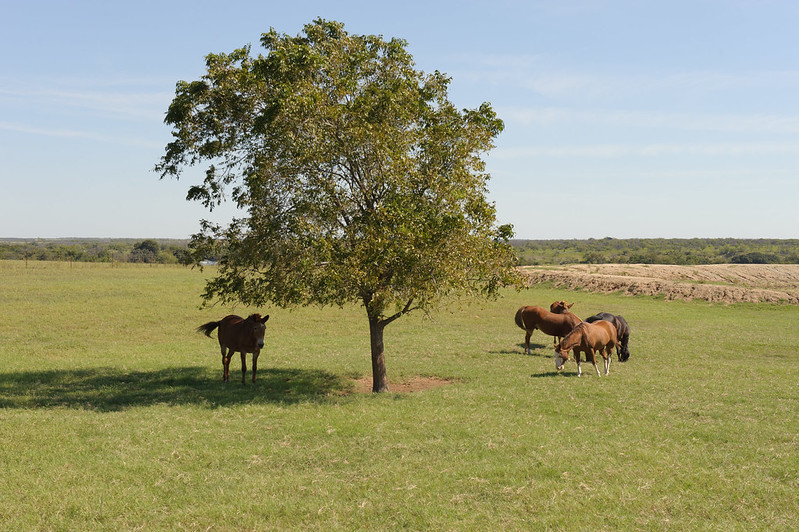This is the second in a series of articles focusing on PFC Director Gary Price and his family’s 77 Ranch in Texas.
Around the turn of the 20th century, the Blackland Prairie region of north central Texas supported a massive amount of cotton production. Gary Price points out that “Ellis County, in which part of our ranch is located, had more cotton than than any other county in the country!” That’s how the region’s deep, black soils—the product of centuries of native prairie plant production—eventually wound up with less than 1% of its native sod unplowed. The Blackland Prairie is a long narrow region that covers roughly 50,000 square kilometers running north to south and encompassing Dallas-Ft. Worth.
When cotton gave way to bermuda grass
In the wake of the Great Depression, most of the cotton farms gave way to cattle ranching, where the installation of bermuda grass became the standard. That’s part of what makes the 2,500-acre 77 Ranch special. Owned and operated by Gary Price, his wife Sue, and his son Gary Lee, the ranch is almost exclusively in native grass. “That’s what I love and try to manage better,” Gary explains. “The North Pasture on the ranch was never plowed. Its pollinated grasses and plant diversity have been a great teacher to us. The North Pasture has taught us that when you work with the land instead of against it, you can discover what the land can do and how resilient it is.”
The problem with bermuda grass is it has to be fed. Its high rate of production requires fertilizer, plus an occasional plowing to promote water infiltration. “But you don’t have to do any of those for natives. The production capability of natives is very good, if you look at an efficiency rate that includes no input costs.”
The other advantage is its resiliency. The diversity of prairie plants means they mature at different times of the year: early spring, summer, fall, and even winter. It’s a system that can support year-round grazing. “When you opt for a monoculture, you’re putting all your eggs in one basket,” warns Gary. He doesn’t like being at the whim of changes in the price of fertilizer. The bermuda system depends on fertilizing, as well as rainfall to make it efficient. “I don’t like being dependent on things that I don’t control, it’s not a good practice for any business.”
What wants to grow on the land
In an arid water-limited state like Texas, many questions about ranching revolve around the issue of how to conserve water. “You do that by finding out what wants to grow on the land, the natives are adapted for the conditions. I have a respect for them; I don’t think I know more than they know. I try to get in step with them instead of fighting them.”
A native grass plant that grows 6 feet tall will have roots that reach 10 to 12 feet into the soil, down where the water remains during a drought. “It’s pretty neat,” Gary exclaims, “shade on the ground retards and lessens evaporation, cools the ground, lets the plants absorb the moisture. Bare ground is our enemy.” Gary takes the perspective that anything that wants to grow on a piece of ground (often weeds early on, when converting to natives) is a symptom of what’s going on and is the prairie trying to heal itself.
“Why spray it and kill it and create more bare ground?” Gary asks. “Part of the issue is that droughts during the Depression, followed by heavy rains resulted in a lot of lost topsoil. Now we have to work with what we have, and there are fragile areas where we have to work very cautiously.”
Bad management and good management, separated by a fence
“Seeing the never-plowed North Pasture is the best teacher you could possibly have!” says Gary. “Over the course of 43 years we’ve added 15 different properties, and it’s almost like a laboratory of bad management compared to good management, separated by a fence. In 2011, during the worst drought ever experienced in Texas, the Price ranch had 53 stock tanks go completely dry. “But to see the resiliency of those native plants in our North Pasture reaffirmed we were on the right track. They went dormant, but they lived. A few even died (including some 150-year-old pecan trees), but it was nothing like the bermuda that went completely dormant or died, leaving bare ground. We’re looking at the long haul to create flexibility in how we grow grass and how we market cattle.”
Connected—whether we know it or not
The long haul sums up why Gary and his wife Sue, a Director with the Texas Wildlife Association, host a L.A.N.D.S. (Learning Across New Dimensions in Science) program on their property. L.A.N.D.S. seeks to provide school children from both urban and rural areas a greater connection to the land, using water as the common denominator of interest. “Everyone drinks it. You want clean water, and grass is a filter,” says Gary. “We tell the story of cattle and what they do for the land to the kids and even some parents who come along.”
“Our feeling is we’re all in this together—we are all connected to the land whether we know it or not. We all have to eat everyday, and our food originates on the land, but it’s really more than that. Land is finite, and we can do a lot of things that destroy it, which then take thousands of years to rebuild. By working with the next generation, we are investing in what happens way after we are all gone.”
Read the rest of the series:
Article 1. Covid Concerns on the Ranch: Restaurants, processors, and the closeness entailed in loading a cow into a trailer
Article 3. From Cow to Consumer, a new focus on Grassland Soil Stewardship
Article 4. The 77 Ranch Ethos: Reverence for the Land and Partnerships with People

